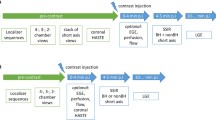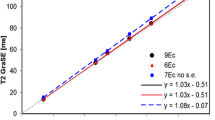Abstract
Our aim was to determine the diagnostic value of myocardial tagging sequences with regard to the evaluable share of the cardiac cycle. Thirty-three patients were examined at 1.5 T using tagging sequences with gradient-echo (GRE) readout, 18 patients at 1.5 T with steady-state free precession (SSFP), and 11 patients at 3 T using GRE. Two observers graded image quality and determined the share of the cardiac cycle for which postprocessing could be performed (1, optimal; 2, little interaction; 3, whole cycle assessable; 4, diastole non-assessable; 5, systole incomplete; 6, non-diagnostic). With GRE at 1.5 T, median image quality was 4.0 (95% CI 4.0–5.0), while it was significantly better with 2.0 (2.0–3.0) using the SSFP technique and similar at 3 T with 2.9 (1.7–3.5). With GRE at 1.5 T, systole could be assessed in 69% of patients, and an evaluation of the whole cardiac cycle was not possible. With the SSFP sequence at 1.5 T and GRE at 3 T, an evaluation of the whole cardiac cycle was possible in 71% and 70% of the patients, respectively, and systole was assessable in all patients. Tagging sequences with SSFP readout at 1.5 T make a semi-automatic evaluation of the whole cardiac cycle feasible in a large share of patients.






Similar content being viewed by others
References
Zerhouni EA, Parish DM, Rogers WJ, Yang A, Shapiro EP (1988) Human heart: tagging with MR imaging—a method for noninvasive assessment of myocardial motion. Radiology 169:59–63
Axel L, Dougherty L (1989) MR imaging of motion with spatial modulation of magnetization. Radiology 171:841–845
Fischer SE, McKinnon GC, Maier SE, Boesiger P (1993) Improved myocardial tagging contrast. Magn Reson Med 30:191–200
Mosher TJ, Smith MB (1990) A DANTE tagging sequence for the evaluation of translational sample motion. Magn Reson Med 15:334–339
Stuber M, Fischer SE, Scheidegger MB, Boesiger P (1999) Toward high-resolution myocardial tagging. Magn Reson Med 41:639–643
Peters DC, Epstein FH, McVeigh ER (2001) Myocardial wall tagging with undersampled projection reconstruction. Magn Reson Med 45:562–567
Ryf S, Kissinger KV, Spiegel MA, Bornert P, Manning WJ, Boesiger P, Stuber M (2004) Spiral MR myocardial tagging. Magn Reson Med 51:237–242
Herzka DA, Guttman MA, McVeigh ER (2003) Myocardial tagging with SSFP. Magn Reson Med 49:329–340
Zwanenburg JJM, Kuijer JPA, Marcus JT, Heethaar RM (2003) Steady-state free precession with myocardial tagging: CSPAMM in a single breathhold. Magn Reson Med 49:722–730
Johnson T, Hahn D, Sandstede J (2004) Quantitative analysis of left ventricular wall motion with MRI tagging. Radiologe 44:158–163
Kramer U, Deshpande V, Fenchel M, Klumpp B, Laub G, Finn JP, Claussen CD, Miller S (2006) Cardiac MR tagging: optimization of sequence parameters and comparison at 1.5 T and 3.0 T in a volunteer study. Rofo 178:515–524
Matter C, Nagel E, Stuber M, Boesiger P, Hess OM (1996) Assessment of systolic and diastolic LV function by MR myocardial tagging. Basic Res Cardiol 91(Suppl 2):23–28
Stuber M, Scheidegger MB, Fischer SE, Nagel E, Steinemann F, Hess OM, Boesiger P (1999) Alterations in the local myocardial motion pattern in patients suffering from pressure overload due to aortic stenosis. Circulation 100:361–368
Sandstede JJ, Johnson T, Harre K, Beer M, Hofmann S, Pabst T, Kenn W, Voelker W, Neubauer S, Hahn D (2002) Cardiac systolic rotation and contraction before and after valve replacement for aortic stenosis: a myocardial tagging study using MR imaging. AJR Am J Roentgenol 178:953–958
Nagel E, Stuber M, Lakatos M, Scheidegger MB, Boesiger P, Hess OM (2000) Cardiac rotation and relaxation after anterolateral myocardial infarction. Coron Artery Dis 11:261–267
Dornier C, Somsen GA, Ivancevic MK, Osman NF, Didier D, Righetti A, Vallee JP (2004) Comparison between tagged MRI and standard cine MRI for evaluation of left ventricular ejection fraction. Eur Radiol 14:1348–1352
Kuijpers D (2005) Diagnosis of coronary artery disease with dobutamine-stress MRI. Eur Radiol 15(Suppl 2):B48–B51
Strach K, Meyer C, Schild H, Sommer T (2006) Cardiac stress MR imaging with dobutamine. Eur Radiol 16:2728–2738
Marcus JT, Gotte MJW, Van Rossum AC, Kuijer JPA, Heethaar RM, Axel L, Visser CA (1997) Myocardial function in infarcted and remote regions early after infarction in man: assessment by magnetic resonance tagging and strain analysis. Magn Reson Med 38:803–810
Kramer CM, Rogers WJ, Theobald TM, Power TP, Petruolo S, Reichek N (1996) Remote noninfarcted region dysfunction soon after first anterior myocardial infarction. A magnetic resonance tagging study. Circulation 94:660–666
Sandstede J, Machann H, Machann W, Beer M, Johnson T, Harre K, Pabst T, Kenn W, Hahn D (2002) Interindividual-variability of the analysis of regional myocardial wall function after myocardial infarction and revascularization. Rofo 174:1147–1153
Osman NF, Kerwin WS, McVeigh ER, Prince JL (1999) Cardiac motion tracking using CINE harmonic phase (HARP) magnetic resonance imaging. Magn Reson Med 42:1048–1060
Ryf S, Spiegel MA, Gerber M, Boesiger P (2002) Myocardial tagging with 3D-CSPAMM. J Magn Reson Imaging 16:320–325
Gotte MJW, van Rossum AC, Twisk JWR, Kuijer JPA, Marcus JT, Visser CA (2001) Quantification of regional contractile function after infarction: strain analysis superior to wall thickening analysis in discriminating infarct from remote myocardium. J Am Coll Cardiol 37:808–817
Gutberlet M, Schwinge K, Freyhardt P, Spors B, Grothoff M, Denecke T, Ludemann L, Noeske R, Niendorf T, Felix R (2005) Influence of high magnetic field strengths and parallel acquisition strategies on image quality in cardiac 2D CINE magnetic resonance imaging: comparison of 1.5 T vs. 3.0 T. Eur Radiol 15:1586–1597
Schar M, Kozerke S, Fischer SE, Boesiger P (2004) Cardiac SSFP imaging at 3 Tesla. Magn Reson Med 51:799–806
Acknowledgements
Significant parts of the data for this study were acquired by N. Bayrhof as parts of the research for their doctoral thesis at the Medical Faculty of the University of Munich.
Author information
Authors and Affiliations
Corresponding author
Rights and permissions
About this article
Cite this article
Johnson, T.R.C., Bayrhof, N., Huber, A. et al. Myocardial tagging with steady state free precession techniques and semi-automatic postprocessing—impact on diagnostic value. Eur Radiol 17, 2218–2224 (2007). https://doi.org/10.1007/s00330-007-0639-5
Received:
Revised:
Accepted:
Published:
Issue Date:
DOI: https://doi.org/10.1007/s00330-007-0639-5




